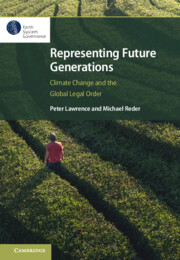Book contents
- Representing Future Generations
- Series page
- Representing Future Generations
- Copyright page
- Contents
- Preface
- 1 Introduction
- Part I Normative Framework
- Part II International Law and Institutions
- 4 Criteria for Evaluating Mechanisms for Representation of Future Generations
- 5 Lessons from Existing International Institutions to Represent Vulnerable Groups
- Part III Case Studies
- Index
- References
4 - Criteria for Evaluating Mechanisms for Representation of Future Generations
from Part II - International Law and Institutions
Published online by Cambridge University Press: 19 September 2025
- Representing Future Generations
- Series page
- Representing Future Generations
- Copyright page
- Contents
- Preface
- 1 Introduction
- Part I Normative Framework
- Part II International Law and Institutions
- 4 Criteria for Evaluating Mechanisms for Representation of Future Generations
- 5 Lessons from Existing International Institutions to Represent Vulnerable Groups
- Part III Case Studies
- Index
- References
Summary
Chapter 4 involves a focus on the legitimacy and effectiveness of proxy-style institutions for future generations. It sets out criteria for assessing the legitimacy of such institutions based on Klaus Dingwerth, Sylvia Karlsson-Vinkhuyzen, and Antto Vihma. Criteria for assessing the legitimacy of international tribunals are developed based on an extension of Bogdandy and Venzke’s work with the idea of accountability to the demos being extended to include future generations. A concept of ‘future legitimacy’ is introduced which involves assessing institutions in operation now from the perspective of future generations when climate change is predicted to be ravaging the planet. Criteria for effectiveness are elaborated involving the Paris Agreement goals, as well as an assessment of the promotion of intergenerational justice and the values of inclusiveness, solidarity and addressing vulnerability. Particular challenges in application of these criteria in the context of international law and related institutions which represent future generations are discussed.
Keywords
Information
- Type
- Chapter
- Information
- Representing Future GenerationsClimate Change and the Global Legal Order, pp. 93 - 115Publisher: Cambridge University PressPrint publication year: 2025
References
Accessibility standard: WCAG 2.0 A
Why this information is here
This section outlines the accessibility features of this content - including support for screen readers, full keyboard navigation and high-contrast display options. This may not be relevant for you.Accessibility Information
Content Navigation
Allows you to navigate directly to chapters, sections, or non‐text items through a linked table of contents, reducing the need for extensive scrolling.
Provides an interactive index, letting you go straight to where a term or subject appears in the text without manual searching.
Reading Order & Textual Equivalents
You will encounter all content (including footnotes, captions, etc.) in a clear, sequential flow, making it easier to follow with assistive tools like screen readers.
Structural and Technical Features
You gain clarity from ARIA (Accessible Rich Internet Applications) roles and attributes, as they help assistive technologies interpret how each part of the content functions.
